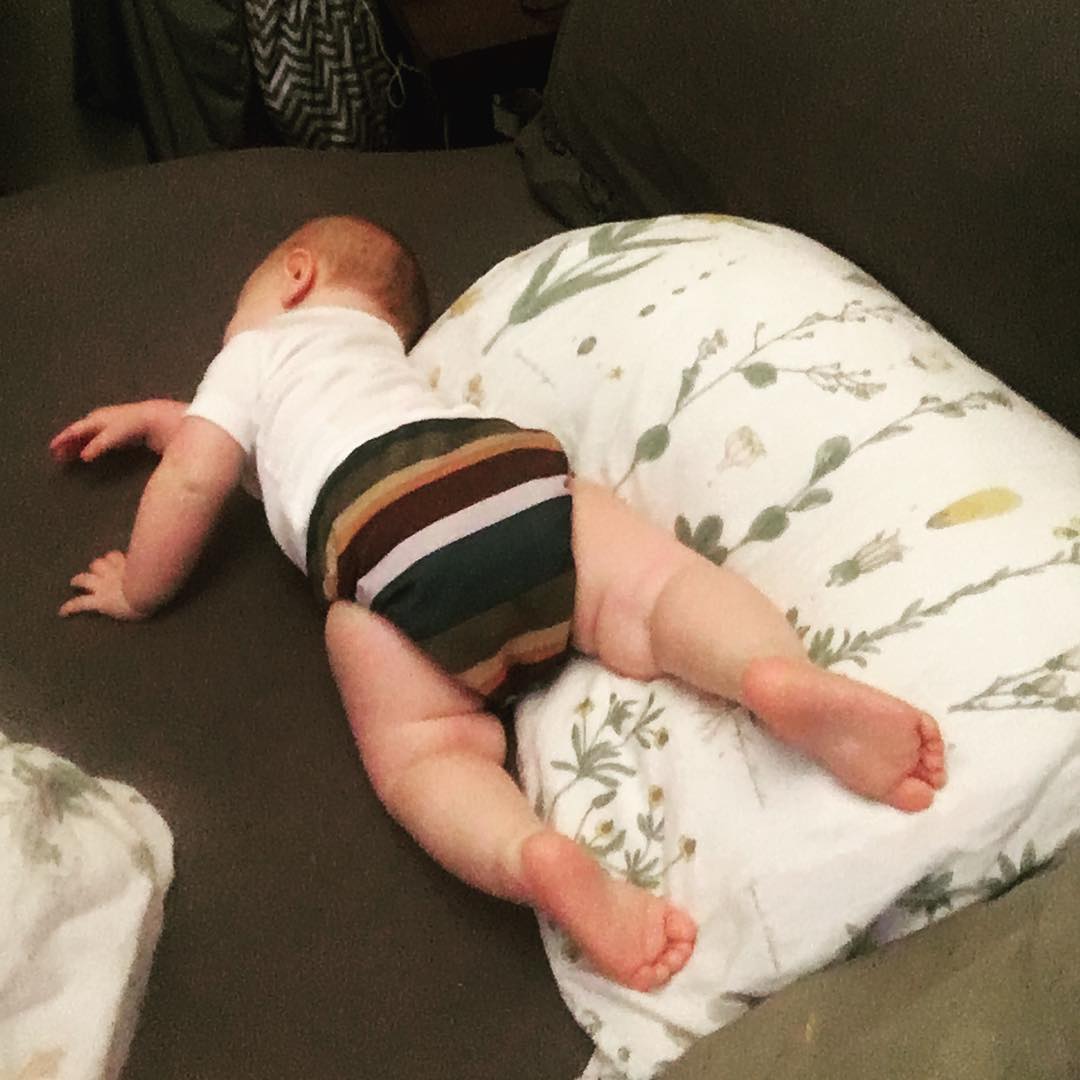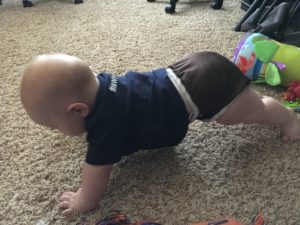🔥 Let's Talk Baby Fevers 🔥
Nothing is more sad than seeing your energetic little love feeling icky. Especially when they don't completely understand what they are feeling. Being sick is hard for everyone, but being a parent of a sick babe comes with its own challenges. For many people the gut reaction may be to jump straight for the Baby Motrin and make it all better. (Trust me, I have been there)
BUT for all intents and purposes, fevers are a GOOD thing!
They are a sign that the immune system is working by heating up the body and killing viruses, and when it all blows over, your babe will come back even stronger meaning more time between sickness and faster recovery times during. 💪🏼
For healthy babes, MOST fevers are manageable, beneficial, and should be left run their course.
So What To Do When You Feel Stuck and Helpless While "Waiting it Out"
Here are my top tips and tools for HELPING a fever to do its job safely and break on its own: reducing sick time, keeping baby comfortable, and boosting that immune system:
❤️ Treat the Baby not the Fever
Some babes wake up with temperatures of 101° and are prepared to flip cartwheels. While other times, they might wake with a 98.7° temp and look like a bus hit them in their sleep (This was me yesterday). Follow those cues when it comes to your babe. The fever is part of the body doing it's job, a tool designed for the body to fight off the ickies. Instead of trying to take it away, focus on the meeting the needs your child is expressing.
💜 Elderberry and Vitamin C Popsicles
Sometimes it's hard to get liquids into your kids when they feel sick. These popsicles help to boost the body's immune system super powers and taste good. I make mine from scratch with some elderberry syrup, a Vitamin C powder (like Emergen-C) and a small amount of Vitamin C in a powder form. Try it before you freeze it so that you make sure it's not too bitter.
🧡 Yarrow, Lavender, and Chamomile Herbal Bags for Bath, Blankets, and Bed
THIS is my number one go-to when it comes to fever support. Due to their developing bodies, Littles (Under 2) need to receive herbal support (and essential oil support) in a much more cautious and conscientious way than older children and adults. The best and safest way for them to absorb most herbs is topically with an herbal infusion. This is where these herbal bath bags come in. I use these muslin bath bags and fill them with Yarrow, Lavender, and Chamomile. The Chamomile and Lavender calm and relax baby so that they are ready to relax and let their bodies heal. The Yarrow is the star of the show when it comes to fever support. Yarrow is a do-it-all herb for flu and fever. It is both anti-inflammatory and antimicrobial. It is also an anti-catarrhal (eliminates mucous from the body - Those stuffy noses and throat drainage anyone?). Plus it also acts as a mild sedative. These three together are champions of sick babies.
I add these dry herbs to a muslin bag and boil them in an electric kettle, let it "steep", then pour the water in the bath. You can put the bag in the water to keep steeping OR you can let it cool, wring it out, and pop it into the dryer with a dry towel. The herbs will dry out again and give you some aromatherapy for your warm towel you will wrap baby in out of the tub.
Once dried the herbal bag can be put near babies bed (out of reach for the younger ones, or under the fitted sheet for older kids) and add to the aromatherapy in the room.
You can also save the dry bag for another bath if you would like, just make sure it is completely dry (and that you didn't put it in the bathwater) before storing.
💙 Hydrate, Hydrate, Hydrate (Breastfeeding, Water, and Electrolytes)
I can't stress this enough. The biggest danger with high fevers is the risk of brain damage from stroke. This is because of dehydration. The body is heating up and using fluids and electrolytes at a much higher rate than normal. Dehydrated babies are the ones at highest risk for the dangerous aspects of fevers. Hydrate, Hydrate, Hydrate. Especially in the bathtub. Humans lose a lot more fluids sitting in a big bowl of hot water than you would think. For babies under 6 months, breastfeeding (if you are already), and then for older than 6 months add on water and fluids with electrolytes (coconut water, smart water, or make your own with some juice and essential minerals (NOT ESSENTIAL OILS: MINERALS). Once I stayed up all night with my son, a sippy cup of water on one side, my boobs in the middle, and a sippy cup of coconut water on the other side. He went back and forth between all three - A hydration circuit while he slept.
If you can only take one thing from this post - take hydration.
💛 Resist the Urge to Cool Your Baby Down
Trying to cool a fever will only prolong the sickness and won't do much to help the immune system produce the antibodies needed to do a more productive and proactive job next time. Think about what your body needs when it has a fever. The chills, feeling cold, needing to snuggle under a thousand blankets - these are all ways the body reminds you to get warm and cultivate your fever so that it fights off the virus and breaks.
There are, of course exceptions to any rule. If your baby reaches fevers of unsafe and unmanageable temperatures with other lethargic symptoms to show for it, then it is time to whip out the meds and bring that fever down.
PLEASE NOTE: This guide is for babies 3 months - 3 years. Any newborn fever (even slight) is a reason to call your provider and get support. Temperatures that should have a call in to the pediatrician's office for other ages are:
3 months - 3 years: Higher than 102°
3 years and up: Higher than 103° or have had a 102° or higher for more than 2 days
If your child experiences any of the following with their fever, head straight to the ER:
-
Your child is not breathing or has trouble breathing
-
Severe abdominal pain
-
Your child has a seizure
-
Your child has any other apparent problems, such as swelling or trouble swallowing
ok, now that we have addressed that - moving on..
💚 Follow Babies Cues for Rest, Food, and Sleep
This may mean putting a pause on your sleep training a schedule if you have one. Sickness and fevers are a situation out of the normal that require extra care - and a lot of that care is instinctual to what your baby needs. Some kids won't want to eat, they may want to take a 4-hour nap at a weird time during the day, or cuddle for hours. These are all observational tools for you to learn when things are getting better or worse. Listen to your baby, things will be back on track soon.
💖 For Breastfeeding Parents - KISS YOUR BABIES
Obviously, if you are not breastfeeding feel free to kiss your babies, too (unless you have an immunocompromised body). But it's good to note that you create antibodies in your breastmilk for your baby through two common ways - baby's saliva on your nipples when nursing and from you sampling baby's microbes with your mouth (AKA kisses). Also snuggles just feel safe to your babes. But please take care of your own immune system as well, otherwise this might become a great list for your own fever.
DISCLAIMER: I am not a medical professional. This information comes from personal experience, the experiences of my clients, evidence-based research, and anecdotal evidence. If, at any point during your pregnancy or postpartum period you have a question or concern, please contact your care provider for medical support.





